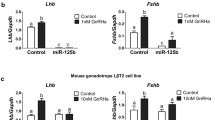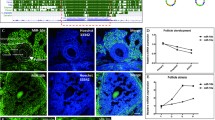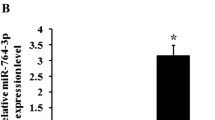Abstract
Gonadotropin-releasing hormone (GnRH) is the initial central regulator of the animal reproduction system, which is crucial for puberty onset and fertility. However, the mechanisms regulating GnRH production and release remain unclear. In addition, few studies reported that miR-375 expressed in mouse hypothalamus, but up to now there are limited functional studies of miR-375 in regulating GnRH secretion. According to our recent findings that miR-375 was involved in regulating the synthesis and secretion of pituitary hormones, thus, we aimed to identify the role of miR-375 in regulating GnRH production in GT1-7 cells. Immunofluorescence results demonstrated that miR-375 was expressed in all of the GT1-7 cells. The functional studies showed that miR-375 overexpression enhanced GnRH mRNA expression level, but decreased the mRNA expressions of Sp1, Cebpb, Msx1, and Tle4. Transcriptomics analysis demonstrated Sp1 and Tle4 acted as the targeting genes of miR-375, and Sp1 negatively regulated Gnrh mRNA expression by binding to the Gnrh promoter. Thus, we conclude that miR-375 potentially enhances GnRH expression by targeting Sp1 and Tle4 in GT1-7 cells. Our results highlight a critical role of miR-375 in regulating GnRH production, which may provide a novel potential therapeutic approach to neuroendocrine-disorder-related dysfunctions.





Similar content being viewed by others

References
Allen MP, Linseman DA, Udo H, Xu M, Schaack JB, Varnum B, Kandel ER, Heidenreich KA, Wierman ME (2002) Novel mechanism for gonadotropin-releasing hormone neuronal migration involving Gas6/Ark signaling to p38 mitogen-activated protein kinase. Mol Cell Biol 22:599–613
Baroukh NN, Van Obberghen E (2009) Function of microRNA-375 and microRNA-124a in pancreas and brain. FEBS J 276:6509–6521
Belsham DD, Mellon PL (2000) Transcription factors Oct-1 and C/EBPbeta (CCAAT/enhancer-binding protein-beta) are involved in the glutamate/nitric oxide/cyclic-guanosine 5′-monophosphate-mediated repression of mediated repression of gonadotropin-releasing hormone gene expression. Mol Endocrinol 14:212–228
Christian CA, Moenter SM (2010) The neurobiology of preovulatory and estradiol-induced gonadotropin-releasing hormone surges. Endocr Rev 31:544–577
Cimino I, Casoni F, Liu X, Messina A, Parkash J, Jamin SP, Catteau-Jonard S, Collier F, Baroncini M, Dewailly D, Pigny P, Prescott M, Campbell R, Herbison AE, Prevot V, Giacobini P (2016) Novel role for anti-Mullerian hormone in the regulation of GnRH neuron excitability and hormone secretion. Nat Commun 7:10055
Dulcis D, Lippi G, Stark CJ, Do LH, Berg DK, Spitzer NC (2017) Neurotransmitter switching regulated by miRNAs controls changes in social preference. Neuron 95:1319–1333 e5
El Ouaamari A, Baroukh N, Martens GA, Lebrun P, Pipeleers D, van Obberghen E (2008) miR-375 targets 3′-phosphoinositide-dependent protein kinase-1 and regulates glucose-induced biological responses in pancreatic beta-cells. Diabetes 57:2708–2717
Fiore R, Khudayberdiev S, Saba R, Schratt G (2011) MicroRNA function in the nervous system. Prog Mol Biol Transl Sci 102:47–100
Gai Y, Zhang J, Wei C, Cao W, Cui Y, Cui S (2017) miR-375 negatively regulates the synthesis and secretion of catecholamines by targeting Sp1 in rat adrenal medulla. Am J Phys Cell Phys 312:C663–C672
Gonzalez-Martinez D, Hu Y, Bouloux PM (2004) Ontogeny of GnRH and olfactory neuronal systems in man: novel insights from the investigation of inherited forms of Kallmann’s syndrome. Front Neuroendocrinol 25:108–130
Herbison AE (2016) Control of puberty onset and fertility by gonadotropin-releasing hormone neurons. Nat Rev Endocrinol 12:452–466
Kang L, Cui X, Zhang Y, Yang C, Jiang Y (2013) Identification of miRNAs associated with sexual maturity in chicken ovary by Illumina small RNA deep sequencing. BMC Genomics 14:352
Lee VH, Lee LT, Chow BK (2008) Gonadotropin-releasing hormone: regulation of the GnRH gene. FEBS J 275:5458–5478
Maggi R (2017) Cell-based models to study GnRH neuron physiology. MOJ Anat Physiol:3
Mellon PL, Windle JJ, Goldsmith PC, Padula CA, Roberts JL, Weiner RI (1990) Immortalization of hypothalamic GnRH neurons by genetically targeted tumorigenesis. Neuron 5:1–10
Messina A, Langlet F, Chachlaki K, Roa J, Rasika S, Jouy N, Gallet S, Gaytan F, Parkash J, Tena-Sempere M, Giacobini P, Prevot V (2016) A microRNA switch regulates the rise in hypothalamic GnRH production before puberty. Nat Neurosci 19:835–844
Ojeda SR, Lomniczi A (2014) Puberty in 2013: unravelling the mystery of puberty. Nat Rev Endocrinol 10:67–69
Okitsu-Sakurayama S, Higa-Nakamine S, Torihara H, Takahashi H, Higashiyama S, Yamamoto H (2019) Activation of Pyk2 by CaM kinase II in cultured hypothalamic neurons and gonadotroph cells. J Cell Physiol 234:6865–6875
Poy MN, Eliasson L, Krutzfeldt J, Kuwajima S, Ma X, Macdonald PE, Pfeffer S, Tuschl T, Rajewsky N, Rorsman P, Stoffel M (2004) A pancreatic islet-specific microRNA regulates insulin secretion. Nature 432:226–230
Quinn JJ, Chang HY (2016) Unique features of long non-coding RNA biogenesis and function. Nat Rev Genet 17:47–62
Roy D, Angelini NL, Belsham DD (1999) Estrogen directly represses gonadotropin-releasing hormone (GnRH) gene expression in estrogen receptor-alpha (ER alpha)- and ER beta-expressing GT1-7 GnRH neurons. Endocrinology 140:5045–5053
Roy D, Angelini NL, Fujieda H, Brown GM, Belsham DD (2001) Cyclical regulation of GnRH gene expression in GT1-7 GnRH-secreting neurons by melatonin. Endocrinology 142:4711–4720
Tata B, Mimouni NEH, Barbotin AL, Malone SA, Loyens A, Pigny P, Dewailly D, Catteau-Jonard S, Sundstrom-Poromaa I, Piltonen TT, Dal Bello F, Medana C, Prevot V, Clasadonte J, Giacobini P (2018) Elevated prenatal anti-Mullerian hormone reprograms the fetus and induces polycystic ovary syndrome in adulthood. Nat Med 24:834–846
Tsutsumi R, Webster NJ (2009) GnRH pulsatility, the pituitary response and reproductive dysfunction. Endocr J 56:729–737
Wang Z, Gai Y, Zhou J, Liu J, Cui S (2019) miR-375 mediates the CRF signaling pathway to regulate catecholamine biosynthesis by targeting Sp1 in porcine adrenal gland. Stress 22:332–346
Yu C, Li M, Wang Y, Liu Y, Yan C, Pan J, Liu J, Cui S (2016) MiR-375 mediates CRH signaling pathway in inhibiting E2 synthesis in porcine ovary. Reproduction 153:63–73
Zhang N, Lin JK, Chen J, Liu XF, Liu JL, Luo HS, Li YQ, Cui S (2013) MicroRNA 375 mediates the signaling pathway of corticotropin-releasing factor (CRF) regulating pro-opiomelanocortin (POMC) expression by targeting mitogen-activated protein kinase 8. J Biol Chem 288:10361–10373
Funding
This work was supported by the National Key Research and Developmental Program of China (2018YFC1003504), the Natural Science Foundation of China (31430083, 31772692), and the Project of the Priority Academic Program Development of Jiangsu Higher Education Institutions (PAPD).
Author information
Authors and Affiliations
Corresponding author
Ethics declarations
Conflict of interest
The authors declare that there is no conflict of interest.
Additional information
Editor: Tetsuji Okamoto
Rights and permissions
About this article
Cite this article
Li, H., Li, X., Zhang, D. et al. MiR-375 potentially enhances GnRH expression by targeting Sp1 in GT1-7 cells. In Vitro Cell.Dev.Biol.-Animal 57, 438–447 (2021). https://doi.org/10.1007/s11626-020-00447-4
Received:
Accepted:
Published:
Issue Date:
DOI: https://doi.org/10.1007/s11626-020-00447-4



